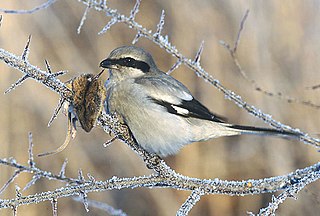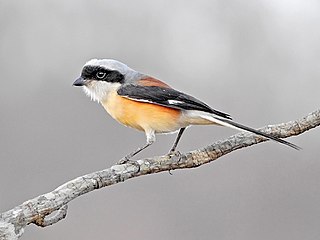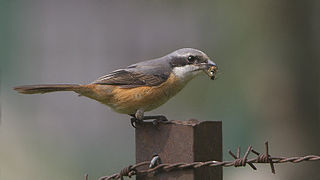
Shrikes are carnivorous passerine birds of the family Laniidae. The family is composed of 33 species in four genera.

The great grey shrike, known as the northern shrike in North America, is a large songbird species in the shrike family (Laniidae). It forms a superspecies with its parapatric southern relatives, the Iberian grey shrike, the Chinese grey shrike and the loggerhead shrike. Males and females are similar in plumage, pearly grey above with a black eye-mask and white underparts.

The red-backed shrike is a carnivorous passerine bird and member of the shrike family Laniidae. The breeding range stretches from Western Europe east to central Russia but it only rarely occurs in the British Isles. It is migratory and winters in the western areas of tropical Africa.

The woodchat shrike is a member of the shrike family Laniidae. The genus name, Lanius, is derived from the Latin word for "butcher", and some shrikes are also known as "butcher birds" because of their feeding habits. The specific senator is Latin for "senator", so-named because its chestnut cap recalled the colour of the stripe on the toga of a Roman senator. The common name "Woodchat" is an Anglicisation of German waldkatze, literally "woodcat", and "shrike" is from Old English scríc, "shriek", referring to the shrill call.

The Iberian grey shrike is a member of the shrike family. The plumage is generally similar to great grey shrike apart from the differences noted below. It is closely related to the great grey shrike, Lanius excubitor, which it was previously considered conspecific; where they co-occur, they do not interbreed and are separated by choice of habitat.

The lesser grey shrike is a member of the shrike family Laniidae. It breeds in South and Central Europe and western Asia in the summer and migrates to winter quarters in southern Africa in the early autumn, returning in spring. It is a scarce vagrant to western Europe, including Great Britain, usually as a spring or autumn erratic.

The northern shrike is a large songbird species in the shrike family (Laniidae) native to North America and Siberia. Long considered a subspecies of the great grey shrike, it was classified as a distinct species in 2017. Six subspecies are recognised.

The long-tailed shrike or rufous-backed shrike is a member of the bird family Laniidae, the shrikes. They are found widely distributed across Asia and there are variations in plumage across the range. The species ranges across much of Asia, both on the mainland and the eastern archipelagos. The eastern or Himalayan subspecies, L. s. tricolor, is sometimes called the black-headed shrike. Although there are considerable differences in plumage among the subspecies, they all have a long and narrow black tail, have a black mask and forehead, rufous rump and flanks and a small white patch on the shoulder. It is considered to form a superspecies with the grey-backed shrike which breeds on the Tibetan Plateau.

The loggerhead shrike is a passerine bird in the family Laniidae. It is the only member of the shrike family endemic to North America; the related northern shrike occurs north of its range but also in the eastern Palearctic. It is nicknamed the butcherbird after its carnivorous tendencies, as it consumes prey such as amphibians, insects, lizards, small mammals and small birds, and some prey end up displayed and stored at a site, for example in a tree. Due to its small size and weak talons, this predatory bird relies on impaling its prey upon thorns or barbed wire for facilitated consumption. The numbers of Loggerhead shrike have significantly decreased in recent years, especially in Midwestern, New England and Mid-Atlantic areas.
The Sibley-Monroe checklist was a landmark document in the study of birds. It drew on extensive DNA-DNA hybridisation studies to reassess the relationships between modern birds.

The brown shrike is a bird in the shrike family that is found mainly in Asia. It is closely related to the red-backed shrike and isabelline shrike. The genus name, Lanius, is derived from the Latin word for "butcher", and some shrikes are also known as "butcher birds" because of their feeding habits. The specific cristatus is Latin for "crested", used in a broader sense than in English. The common English name "shrike" is from Old English scríc, "shriek", referring to the shrill call.

The masked shrike is a bird in the shrike family, Laniidae. It breeds in southeastern Europe and at the eastern end of the Mediterranean, with a separate population in eastern Iraq and western Iran. It is migratory, wintering mainly in northeast Africa. Although it is a short-range migrant, vagrants have occurred widely elsewhere, including northern and western Europe. It is the smallest member of its genus, long-tailed and with a hooked bill. The male has mainly black upperparts, with white on its crown, forehead and supercilium and large white patches on the shoulders and wings. The throat, neck sides and underparts are white, with orange flanks and breast. The female is a duller version of the male, with brownish black upperparts and a grey or buff tone to the shoulders and underparts. The juvenile has grey-brown upperparts with a paler forehead and barring from the head to rump, barred off-white underparts and brown wings аpart from the white primary patches. The species' calls are short and grating, but the song has melodic warbler-like components.

The bay-backed shrike is a member of the bird family Laniidae, the shrikes, resident in South Asia.

Lanius, the typical shrikes, are a genus of passerine birds in the shrike family. The majority of the family's species are placed in this genus. The genus name, Lanius, is derived from the Latin word for "butcher", and some shrikes are also known as "butcher birds" because of their feeding habits. The common English name "shrike" is from Old English scríc, "shriek", referring to the shrill call.

The tiger shrike or thick-billed shrike is a small passerine bird which belongs to the genus Lanius in the shrike family, Laniidae. It is found in wooded habitats across eastern Asia. It is a shy, often solitary bird which is less conspicuous than most other shrikes. Like other shrikes it is predatory, feeding on small animals. Its nest is built in a tree and three to six eggs are laid.

The Taita fiscal or Teita fiscal is a member of the shrike family found in east Africa from southeastern South Sudan, southern Ethiopia, and western Somalia to northeastern Tanzania. Its habitat is dry open thornbush and acacia and other dry open woodland.

The bull-headed shrike is a passerine bird of eastern Asia belonging to the shrike family Laniidae.

The long-tailed fiscal is a species of bird in the shrike family Laniidae. The species is closely related to the more widespread grey-backed fiscal and is sometimes placed in a separate subgenus, Neolanius, with that species. It is found in southern Somalia, southern and south-eastern Kenya, from the shores of Lake Victoria to the coast; and northern and eastern Tanzania south to Dar es Salaam, with a separate population at Usanga Flats. Its natural habitat is open dry habitats such as dry, treeless savanna, open woodland and cultivated patches.

The grey-backed shrike is a species of bird in the family Laniidae inhabiting the Asian South-east.

The steppe grey shrike is a large songbird species in the shrike family (Laniidae) native to Central Asia and parts of northern China, Iran, Afghanistan and Pakistan. Formerly considered a subspecies of the southern grey shrike complex, it is now classified as a subspecies of the great grey shrike.
















